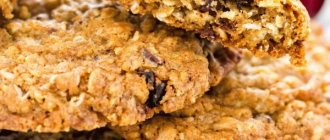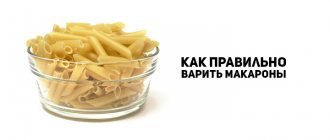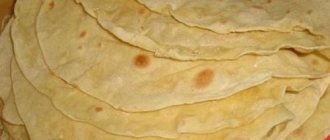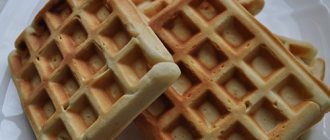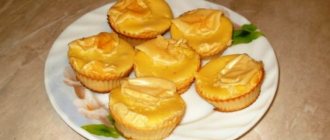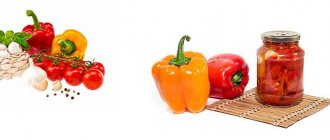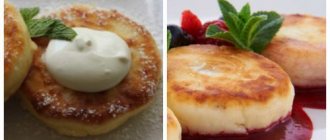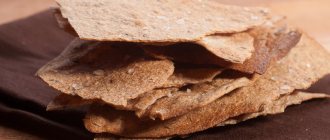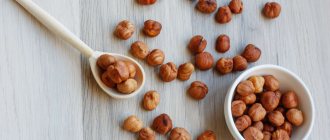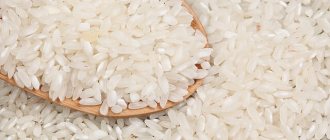Bran is a by-product of flour production. This is a shell that envelops the grain, protects it from external influences, and accumulates useful nutrients and vitamins.
The specificity of bran depends on the grain from which the product was isolated (buckwheat, rice, millet, barley). The product is classified not only by grain, but also by the degree of grinding of the bran: coarse (large, reminiscent of whole grain flakes) and fine (small, similar to flattened and ground grain).
Nutritional value of the ingredient
Initially, the bran was separated from the grain in order to increase the shelf life and preserve the taste of the flour. Excessive amounts of bran, due to the high content of fatty acids, impart bitterness to the grain and reduce its digestibility. A small amount of the hard shell of the grain provides the exact opposite effect: the taste becomes richer and “breadier”, intestinal motility improves, and satiety occurs faster and better.
Content:
- Nutritional value of the ingredient
- Beneficial features
- Chemical composition
- Use in cooking
- Side effects and contraindications
Brief historical background
At the beginning of the twentieth century, the hard shell of grain was completely excluded from the diet of the then Europe. Bran was considered a cheap waste by-product, which the milling industry dumped and burned in tons. By that time, scientists had already acquired some equipment, carefully studied the composition of bran and recognized its high nutritional value.
The end of the twentieth century was marked by a return to origins. Grains are no longer meticulously cleaned, thereby depriving them of beneficial vitamins, micro- and macroelements. Oat bran was the first to return to the diet. They were recognized as a valuable source of dietary fiber, they began to be added to ready-made breakfasts, introduced into low-calorie diets, and added to nutrition programs for those who were trying to lose the hated pounds. A similar practice can still be observed today: bran is popular among vegetarians, adherents of proper nutrition, athletes and those losing weight.
Nutritionists support the desire of the masses for rational nutrition. Fashion trends classify bran as a “superfood” (plant products enriched with vitamins and nutrients) and introduce everyone to good eating habits.
Beneficial features
The benefits of bran are determined by the high content of dietary fiber. They regulate intestinal function, normalize stool, and restore the microflora of the internal environment.
Other benefits of dietary fiber:
- Remove cholesterol from the body.
- They reduce weight due to faster and longer saturation (do not forget about the nutritional value of the ingredient). Bran accelerates metabolism and helps the gastrointestinal tract more easily absorb useful micro- and macroelements.
- Normalize blood sugar levels.
- They have a detox effect.
How bran normalizes cholesterol levels
The product “binds” dietary fiber and bile acids of the stomach. In this way, the degree of activity of the acid is regulated, the level of its aggressiveness in relation to the internal environment is normalized. In addition, bran stimulates the production of B vitamins. Intestinal bacteria, “bound” by dietary fiber, begin intensive production of the vitamin, which supports the functioning of the entire body. Bran slows down the level of starch breakdown and affects the glycemic index of the product (adjusting it to the needs of the body at the moment).
The role of bran in weight loss
Bran contains a high percentage of fiber. Fiber, in turn, is one of the most important products for losing weight and athletes. It is absorbed more slowly, causing the body to feel full for several hours longer, and improves intestinal motility. Fiber minimizes the percentage of nutrient absorption and, thereby, reduces the total caloric intake of the meal. Food enters the body, stimulates satiety, but is only partially absorbed. Unprocessed foods are simply eliminated from the body, rather than remaining as extra inches on the sides.
Fiber does not break down fat deposits, but fights the cause of their accumulation. The substance stimulates the digestive system to work faster, better and more efficiently. Only with this principle of losing weight can you achieve real success.
What is detox and how does bran affect it?
Detox can be compared to the reset button on your phone. We feed the body with toxins through food, bad habits, and an aggressive external environment. Internal cleaning systems simply cannot cope with the entire amount of pathogenic microflora and allow some particles to pass through. These missed particles accumulate and grow, causing disease. Detox presses the reset button, renewing your natural cleansing processes and making them work several times harder, faster and better.
Bran stimulates detox and does a great service to the entire human body. The ingredient breaks down and removes waste, toxins, heavy metals, excess liquid, and pathogenic food breakdown products.
Chemical composition
Nutritional value (per 100 grams of raw bran)
| Characteristic | Wheat | Rye | Oatmeal |
| Calorie content | 165 kcal | 114 kcal | 246 kcal |
| Squirrels | 16 g | 12.2 g | 17.3 g |
| Fats | 3.8 g | 3.4 g | 7 g |
| Carbohydrates | 16.6 g | 8.7 g | 66.2 g |
| Alimentary fiber | 43.6 g | 43.6 g | 15.4 g |
| Water | 15 g | 13.8 g | 6.55 g |
Nutrient balance (in milligrams per 100 grams of raw bran)
| Nutrient | Wheat | Rye | Oatmeal |
| Retinol (A) | – | 0,0166 | – |
| Thiamine (B1) | 0,75 | 0,54 | 1,17 |
| Riboflavin (B2) | 0,26 | 0,28 | 0,22 |
| Choline (B4) | – | – | 32,2 |
| Pantothenic acid (B5) | – | – | 1,5 |
| Pyridoxine (B6) | – | – | 0,165 |
| Folic acid (B9) | – | – | 0,052 |
| Tocopherol (E) | 10,4 | 1,5 | 1,01 |
| Phylloquinone (K) | – | – | 0,032 |
| Nicotinic acid (PP) | 13,5 | 2,07 | 0,934 |
| Potassium (K) | 1260 | 1207 | 566 |
| Calcium (Ca) | 150 | 230 | 58 |
| Magnesium (Mg) | 448 | 448 | 235 |
| Sodium (Na) | 8 | 60 | 4 |
| Phosphorus (P) | 950 | 310 | 734 |
| Iron (Fe) | 14 | 10 | 5,41 |
| Iodine (I) | – | 0,06 | – |
| Cobalt (Co) | – | 0,004 | – |
| Manganese (Mn) | – | 7 | 5,63 |
| Copper (Cu) | – | 0,759 | 0,403 |
| Selenium (Se) | – | – | 0,0452 |
| Zinc (Zn) | – | 4,31 | 3,11 |
How to use bran for weight loss?
Proper use of the product is the key to success. If there was no coarse fiber in the diet before, then at first its dose should not exceed one teaspoon per day. This dosage must be maintained for a week. If there are no side effects, the daily dose is increased to a tablespoon. Then they gradually switch to the main dose - 30 g per day.
It is believed that it is advisable to consume fiber during breakfast. Taking it in the morning ensures you feel full throughout the day, which is especially important when losing weight. Bran sticks are used as a snack between main meals. The duration of the bran diet depends on what specific result the person is striving for.
Bran with kefir
Kefir with bran is used for different purposes: for a fasting day, a mono-diet, or as an integral part of the daily menu. For beginners, it’s definitely better to start with the third option. It is advisable to add them to the diet gradually.
Try mixing one glass of fermented milk drink with a teaspoon of bran. Let sit for 20-30 minutes to swell. It is better to drink the cocktail in the morning, preferably on a day off. Because it is unknown what the body’s reaction to the new supplement will be.
Kefir is an excellent solution for those who do not want to consume bran in its pure form. They can be mixed with first or second courses, but if there is no free time for cooking, they can be successfully combined with a fermented milk drink. It is not necessary to use low-fat or low-fat kefir.
Wheat, oat, flax and rye bran are suitable for making cocktails. Rye beans are first poured with boiling water before use.
Oat bran
Oat bran is the outer layer of the grain, containing more than 90% of all nutrients. The high fiber content provides the nutritional value of the product. This is a combination of beneficial properties and detox effect.
Compound:
- 17.4 g protein;
- 7.04 g fat;
- 51.93 g carbohydrates;
- 15 g fiber.
When combined with water, the rough, insoluble fibrous structure swells and increases in size. This fills space in the stomach, reducing appetite and maintaining a feeling of fullness. Calorie content is 246 kcal.
Wheat bran
The basis of wheat bran is fiber, which swells in the stomach and helps remove toxins from the body. Calorie content - 165 kcal.
Rye bran
The number of calories is 221. The beneficial properties are manifested when using the product in its pure form or in combination with one dish.
Rye bran exhibits excellent cleansing and disinfecting properties. Also used in the complex treatment of constipation, diabetes, and diseases of the cardiovascular system.
The product has a rather coarse structure, so if consumed excessively, it can damage the mucous membrane of the digestive tract. It is recommended to consume the daily dose several times and in combination with plenty of liquid.
Flax bran
Flaxseeds are less popular, but no less useful. Calorie content is 260 kcal. The daily norm is 20-30 g.
They exhibit a strong laxative effect, so they are often consumed with kefir. To avoid dehydration, you need to drink enough water.
Use in cooking
Bran has taken the position of “superfood” in cooking; it is used in the niche of healthy balanced nutrition. How to eat bran:
- Porridge. The bran is placed in boiling water for 20-30 minutes. The product swells, has time to absorb water, and becomes softer and more pliable. The liquid is drained and a coarse, tasteless slurry is obtained. It can be added to desserts, first and second courses, or eaten separately with your favorite sauce or dressing.
- Salad dressing. Bran is added to vegetables in its pure form or mixed with herbs, Greek yogurt or sour cream. It turns out a real vitamin bomb from plant products that have a beneficial effect on the gastrointestinal tract, well-being and external beauty.
- Ingredient for desserts. You can make flour with bran, and from it the right pies, cookies, bread or crispbread. Bran is added to sweet yoghurts and even sweets.
- As a breading. Breadcrumbs are not a proper and healthy ingredient. Bran is an excellent plant-based substitute for a high-carbohydrate product. The frying process is similar and will not cause difficulties even for a beginner. It is recommended to fry bran products in a non-stick frying pan without oil or with a drop of coconut oil.
The maximum benefit of bran is achieved only in the presence of liquid. The product “works” only when it swells in water/milk, absorbs the required percentage of liquid and becomes soft.
Bran pancakes recipe
Nutritional value (per 1 serving of prepared dish)
| Calorie content | Squirrels | Fats | Carbohydrates |
| 156 kcal | 16 g | 7.8 g | 4.1 g |
We will need:
- bran (to taste from any grain) – 2 tablespoons;
- soft paste-like low-fat cottage cheese (sold in briquettes) - 1.5 tablespoons;
- chicken egg – 1 pc.
Preparation
Bran pancakes are the main dish of the Dukan Diet. According to the principles of the diet, such pancakes can be eaten at any time of the day, regardless of the quantity. Low-calorie pancakes are especially loved by French women. Any chain store in France sells vacuum-packed healthy pancakes, which need to be slightly warmed up and safely added to your diet.
Mix bran, egg (you can use a whole egg or just the white) and cottage cheese in a deep container. Heat a non-stick frying pan, pour the batter onto it and form a pancake. Fry for 1-2 minutes on each side until golden brown. Serve immediately after preparation with your favorite sauce or topping.
Apple Nut and Seed Cookies Recipe
Nutritional value (per 1 serving of prepared dish)
| Calorie content | Squirrels | Fats | Carbohydrates |
| 329 kcal | 7.4 g | 19.9 g | 31.7 g |
We will need:
- bran (to taste from any type of grain) – ¼ cup;
- instant oatmeal - ¾ cup;
- applesauce (it is recommended to prepare it yourself from fresh apples) – 250 g;
- almonds – 30 g;
- walnuts – 30 g;
- sunflower seeds – 30 g;
- dried fruits – 100 g;
- nut butter – 2 tablespoons.
Preparation
Finely chop nuts, seeds, dried fruits. Take a deep container and combine all the ingredients in it. Mix the mixture thoroughly and refrigerate for 30-50 minutes (to make the mixture more plastic and pliable). Take out the cooled mass and form several cookies out of it. Prepare a baking sheet and line it with special baking paper that can be used without oil. Place the cookies on baking paper and place in the oven for 40 minutes at 160°C. Serve immediately after cooking or store in a suitable container for 3-4 days.
Product varieties
Bran can be granulated or loose. The first ones are similar to breakfast cereals; they can have different shapes: spherical or stick-shaped. Loose bran - in the form of coarse powder.
In granules
Granulated bran is made using extrusion. This is when the mass is heated to a high temperature.
This hot mixture is then pushed out of the apparatus and into a low pressure area. And now this piece of dense mass breaks, becomes loose and porous.
Thus, bran is obtained in granules. And so far there is no consensus on whether this type of product is useful. Still, it is produced under pressure and high temperature.
be careful
Some manufacturers produce this product with different additives and flavors. It would seem that everything is fine. However, pay attention to the composition. I have bought bran with “Cranberry” or “Apple” flavor several times.
As a result, the ingredients included sugar, flour, salt, and some dyes. Naturally, you can forget about losing weight with such a composition. Plus, they are quite tasty. And you can eat a whole pack without having time to blink an eye.
Friable
Supermarkets have a huge selection of this type of bran. They come from different varieties - buckwheat, millet, flax... And three types are considered the most popular.
Their mineral and vitamin composition is almost the same. The only difference is in the percentage of elements.
Oatmeal
This is the most popular product. It is recommended for use in various diets (for example, in Dukan). Calorie content - 247 kcal. There are vitamins PP, E, B and K.
Wheat
Contains more insoluble fiber. Energy value - 260 kcal. Rich in selenium, iodine, zinc and copper.
Rye
Calorie content - 220 kcal. The composition contains polyunsaturated acids - omega-3 and omega-6.
Just like granulated bran, it can have various additives. Therefore, before purchasing, it is important to ensure the “purity” of the product.
Features of application
Before consuming bran, you should read the following information.
You need to start introducing bran into your diet gradually. 1 tsp is enough. three times a day half an hour before meals. A prerequisite is the consumption of large amounts of water.
This is necessary so that the bran swells in the stomach. It is under this condition that they perform their functions. You can drink any liquid - various teas, freshly squeezed juices, kefir, etc.
The daily dosage of bran is 3 tbsp. l. And it must be divided three times. Otherwise, you can aggravate the gastrointestinal tract.
You can take any type of bran - they are all useful. Just pay attention to the additional ingredients in the composition.
Read more in the article “Bran diet - benefits, menu, features.”
Contraindications
Undoubtedly, this flour product is beneficial for the body. However, there are also pitfalls here. Due to the high fiber content, doctors do not recommend consuming bran for the following people:
- with exacerbation of gastritis;
- stomach and duodenal ulcers;
- children under 2 years old.
Use it correctly
To stay in shape or get your figure in order, you need to use this product correctly.
If you decide to diversify your diet with granulated bran, there are several ways to use it:
- as croutons in a diet salad (for example, in “light” Caesar);
- like cookies for tea;
- dry breakfast with juice or vegetable milk;
- snack on the run;
- replacement for bread;
- like croutons for creamy soup.
Loose bran can be used:
- as a breading for vegetable cutlets;
- as an addition to scrambled eggs (you will get oatmeal pancake);
- in baking healthy bread;
- as an additive to porridge.
Doctors do not recommend consuming bran on a regular basis (daily). Connecting this with the fact that fiber also removes beneficial microflora from the intestines. 2-3 times a week will be enough. Although I personally don't agree with this.
In most cases, when we eat modern foods every day, we do not consume enough fiber. Therefore, adding a couple of spoons to your diet will not cause any harm.
Side effects and contraindications
The ingredient is prohibited from being introduced into the diet for diseases of the gastrointestinal tract at the stage of exacerbation of the pathology. As soon as the inflammatory process goes into remission or disappears completely, it is necessary to examine the body and wait for the doctor’s decision. The specialist will assess the possible risks, draw up an approximate diet and indicate the permissible dosage of bran in the daily nutrition plan.
Remember that excessive passion for even the healthiest and most wholesome foods is fraught with pathology. An imbalance occurs in the body (albeit healthy substances), which leads to unstable functioning of all body systems.
What can uncontrolled consumption of bran lead to:
- Development of diseases of the gastrointestinal tract. Transition of pathologies from a state of remission to an exacerbation stage with additional manifestations and deteriorations.
- Bloating, flatulence.
- Malfunctions of the intestines.
- Hypovitaminosis or “vitamin deficiency.” An imbalance of vitamins and nutrients occurs in the body. A huge hole is formed between the consumption and supply of nutrients, which cannot be filled without therapeutic intervention.
Possible consequences of eating superfood
Best materials of the month
- Coronaviruses: SARS-CoV-2 (COVID-19)
- Antibiotics for the prevention and treatment of COVID-19: how effective are they?
- The most common "office" diseases
- Does vodka kill coronavirus?
- How to stay alive on our roads?
Even if a person is absolutely healthy and full of energy, there is a risk of not getting enough fiber from traditional plant-based foods in the daily diet. Patients often, without a doctor's prescription or apparent reason, administer fiber on their own, without controlling the dose and without monitoring the body's reaction. What this could mean: increased gas formation, nausea/vomiting, bloating, bowel irregularities, disruptions in the level of absorption of some beneficial nutrients.
An adult needs 2-3 tablespoons of fiber per day. There is no need to consume the product in its pure form (this is both problematic and absolutely unappetizing). Use bran instead of harmful breadcrumbs, add it to baked goods and add to salads. Combine the product with a high-quality healthy diet, and if there is the slightest malfunction in the body, consult a doctor.
Combination with medications
It is forbidden to use medicines together with bran. The product acts as an active substance that is capable of breaking down elements of the composition of medications. Bran will simply block the drug and deprive the body of the necessary help. The minimum time interval between food intake (with the addition of bran) and medication should not be less than 6-7 hours.
More fresh and relevant information about health on our Telegram channel. Subscribe: https://t.me/foodandhealthru
We will be grateful if you use the buttons:
Wheat bran: what is it?
In high-tech production, wheat is divided into several grades of flour, grain germ and bran. The latter are the outer shell of wheat. This shell is removed during the processing of the grains of a given grain crop so that the wheat flour is snow-white and has a delicate texture. Wheat bran has the appearance of small and light husks of light beige color with a herbaceous taste and a subtle odor. They, unlike other types of bran, are particularly soft. Therefore, many people begin their acquaintance with grain fiber by consuming wheat bran, and then switch to rye or oat bran, which have a coarser structure.
The outer shell of the wheat grain makes up about 15-17% of the total weight. In the bran part of wheat, in contrast to the core of the grain, up to 90-95% of biologically valuable and beneficial substances for the human body are concentrated.
Bran can be eaten both raw and after cooking. The wheat from which bran is produced grows in Russia, Ukraine, Canada, India, and the USA.
